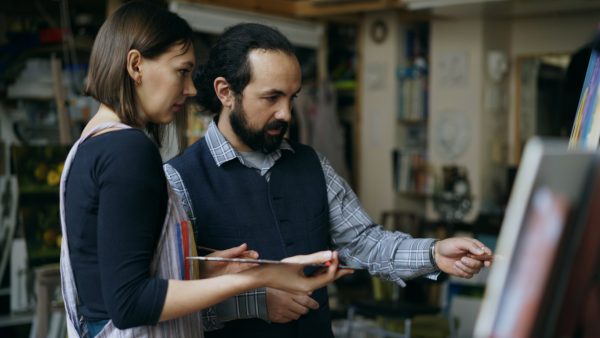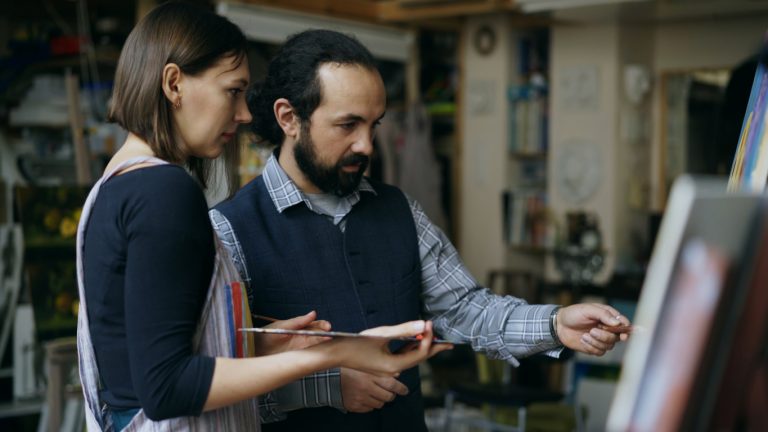One of the most tried and tested paths to success in any profession is to learn from the experience of other successful people. Whatever stage of your career, having a good mentor is essential for your growth as an artist. Even the likes of Da Vinci, Michelangelo and Raphael owe their creative genius, in part, to their shared mentor, Andrea del Verrocchio. But the task of finding a suitable art mentor can be a tricky one. Who exactly should you ask? And how do you persuade someone to invest their time and resources in you? We offer six practical steps toward finding the right career coach for you, and how to maintain that relationship once you’ve achieved it.

1. Decide what kind of mentor you want
In your search for a mentor, the first step is thinking through exactly what kind of experience you’re looking for. Would you be happy to meet online or is face-to-face interaction important to you? Think about how often you’d like to meet, and what kind of guidance you’d benefit from at this point in your career. If you’re just starting off, perhaps you’d like a more instructional mentor to improve your technique, or if you’re mid-career you may consider more of a business-focused exchange. Take into account what kinds of personalities and approaches you usually respond best to. If you prefer gentle characters and casual conversations, reconsider asking the no-nonsense stoic you had in mind.
2. Consider your existing relationships
When thinking of where to locate the people who can support you best, the answer often lies close to home. Think back to your past, is there an old art tutor you particularly admired? Or perhaps someone you’ve shared a studio with? Approaching someone who is already familiar with your work can be a smart decision. A shared cultural background can be an asset when choosing a mentor, as they will implicitly understand the specifics of your work and where you’re coming from. Not only that, but they will likely already have a network of contacts in your area, from gallerists to technicians, that could help you along the way.

3. Integrate yourself
Similarly, it’s important to fully integrate yourself into the local art scene. Follow the work of the artists you admire, comment on and share their work on social media. Attend gallery openings and studio visits and be open and supportive in your interactions. Allow a professional relationship to naturally evolve over time, so that when you finally reach out to them, your request will be welcomed. Your consistent efforts demonstrate to potential mentors that you are in it for the long-haul and show commitment to your professional development. It’s also a great way for you to get to know the person better, and determine whether they’d be a good fit for you.
See our guide on how to build an artist community.
4. Offer something in return
Many working artists today find their time split between their studio practice, and external pursuits such as teaching. Often when managing many different commitments at once, an artist’s time is their most valuable asset. If you’re asking for a portion of that, consider what you could offer in return. Perhaps you could help promote their work on social media, or give their website a revamp? Or maybe you’re great at building stretchers and frames? Be proactive and provide a list of 5–10 tasks that they could delegate to you. This takes the pressure off them to think of something and makes it more likely for them to say yes.
5. Do your homework
Before you approach anyone, it’s essential that you become as familiar as possible with the work they are already doing. It’s not a good look to ask for free mentoring if they already provide a paid mentoring service as part of their business model, for example. Learn more about their work from YouTube videos, blog posts, podcasts or interviews they may have done. If they offer workshops or classes, sign up for one! They are much more likely to help if you show you’ve done your research. When you eventually make your request, be sure to outline the reasons why you are asking them specifically — what is it exactly that you admire about them? What is unique about their work and/or approach? It’s true that flattery can get you anywhere, but only when it’s sincere.

6. Show up and be consistent
So, you’ve sent your request, and to your delight, they’ve accepted! You’re over the first hurdle, but from here on out is where the real work begins. Show up when you say you will and be respectful of their time and advice. Come to each session prepared with a specific list of problems you’re encountering and possible solutions. This eases the burden on them and shows you’re pro-actively contributing. Not only will you become an asset to your mentor, but you will grow as your ability to problem solve sharpens. Show gratitude and report back every so often, highlighting the ways in which their advice has helped you. Creating a positive cycle where both parties feel valued and satisfied is the key to sustaining an enriching professional relationship of any kind.







